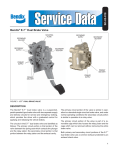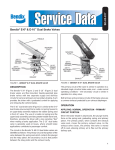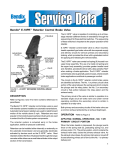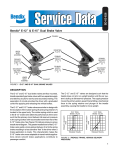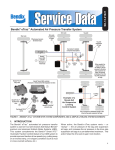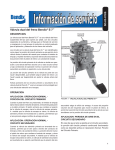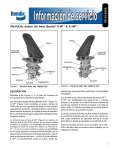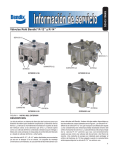Download BENDIX BW1428 User's Manual
Transcript
SD-03-818 ® Bendix® E-7™ Dual Brake Valve DESCRIPTION The Bendix ® E-7 ™ dual brake valve is a suspended, pedal-operated type brake valve with two separate supply and delivery circuits for service and emergency braking, which provides the driver with a graduated control for applying and releasing the vehicle brakes. The circuits in the E-7™ dual brake valve are identified as follows: The primary circuit portion is that portion of the valve between the spring seat which contacts the plunger and the relay piston; the secondary circuit portion is that portion between the relay piston and the exhaust cavity. MOUNTING PLATE SECONDARY DELIVERY SECONDARY SUPPLY PRIMARY SUPPLY The primary circuit portion of the valve is similar in operation to a standard single-circuit air brake valve, and under normal operating conditions the secondary circuit portion is similar in operation to a relay valve. The primary circuit portion of the valve is part of a removable cage which also houses the relay piston and the cage which can be removed without removing the entire brake valve. PRIMARY DELIVERY Both primary and secondary circuit portions of the E-7™ dual brake valve use a common exhaust protected by an exhaust check valve. OPERATION APPLYING: NORMAL OPERATION - PRIMARY CIRCUIT PORTION FIGURE 1 - E-7™ DUAL BRAKE VALVE When the brake pedal is depressed, the plunger exerts force on the spring seat, rubber graduating spring, and primary piston. The primary piston which contains the exhaust valve seat, closes the primary exhaust valve. As the exhaust valve closes, the primary inlet valve is moved off its seat allowing primary air pressure to flow out the delivery port. valve closes, the secondary inlet valve is moved off its seat allowing secondary air pressure to flow out the delivery port. Because of the small volume of air required to move the relay piston, action of the secondary circuit portion of the valve is almost simultaneous with the primary circuit portion. APPLYING: NORMAL OPERATION SECONDARY CIRCUIT PORTION APPLYING: LOSS OF AIR IN SECONDARY CIRCUIT When the primary inlet valve is moved off its seat, air is permitted to pass through the bleed passage and enters the relay cavity. The air pressure moves the relay piston, and the relay piston, which contains the exhaust seat, closes the secondary exhaust valve. As the secondary exhaust Should air be lost in the secondary circuit, the primary circuit portion will continue to function as described above under Normal Operation: Primary Circuit Portion. 1 APPLYING: LOSS OF AIR IN PRIMARY CIRCUIT PREVENTIVE MAINTENANCE Should air be lost in the primary circuit, the function will be as follows: As the brake pedal is depressed and no air pressure is present in the primary circuit supply and delivery ports, the primary piston will mechanically move the relay piston allowing the piston to close the secondary exhaust valve and open the secondary inlet valve and allow air pressure to flow out the delivery port. Important: Review the Bendix Warranty Policy before performing any intrusive maintenance procedures. A warranty may be voided if intrusive maintenance is performed during the warranty period. BALANCED: PRIMARY CIRCUIT PORTION When air pressure delivered to the brake actuators and air pressure in the cavity on the delivery side of the primary piston equals the mechanical force of the brake pedal application, the primary piston will move and the primary inlet valve will close, stopping the further flow of air from the primary supply line through the valve. The exhaust valve remains closed preventing any escape of air through the exhaust port. BALANCED: SECONDARY CIRCUIT PORTION When the air pressure on the secondary side of the relay piston approaches that being delivered on the primary side of the relay piston, the relay piston moves closing the secondary inlet valve and stopping further flow of air pressure from the supply line through the valve. The exhaust remains closed as the pressures balance. When applications in the graduating range are made, a balanced position in the primary portion is reached as the air pressure on the delivery side of the primary piston equals the effort exerted by the driver’s foot on the pedal. A balanced position in the secondary portion is reached when air pressure on the secondary side of the relay piston closely approaches the air pressure on the primary side of the relay piston. When the brake pedal is fully depressed, both primary and secondary inlet valves remain open and full reservoir pressure is delivered out the delivery ports. RELEASING: PRIMARY CIRCUIT PORTION With the brake pedal released, mechanical force is removed from the spring seat, rubber graduating spring, and primary piston. Air pressure and spring load moves the primary piston, opening the primary exhaust valve allowing air pressure in the primary delivery line to exhaust out the exhaust port. RELEASING: SECONDARY CIRCUIT PORTION With the brake pedal released, air is exhausted from the primary side of the relay piston. Air pressure and spring load move the relay piston, opening the secondary exhaust valve allowing air pressure in the secondary delivery line to exhaust out the exhaust port. 2 No two vehicles operate under identical conditions, as a result, maintenance intervals may vary. Experience is a valuable guide in determining the best maintenance interval for air brake system components. At a minimum, the E-7™ valve should be inspected every 6 months or 1500 operating hours, whichever comes first, for proper operation. Should the E-7™ valve not meet the elements of the operational tests noted in this document, further investigation and service of the valve may be required. Every 3 months, 25,000 miles, or 900 operating hours: Lubricate fulcrum and roller pin with Barium grease per BW-204-M (Bendix part 246671). Free pedal travel should be checked as follows: Check to be certain plunger is in contact with spring seat. The stop button should be adjusted so that the roller and plunger just contact. Apply a thin layer of Barium grease, per BW-204-M (Bendix part 246671), between plunger and mounting plate – do not over oil! Clean exhaust check depending on type of service. SERVICE CHECKS OPERATING Check the delivery pressure of both primary and secondary circuits using test gauges known to be accurate. Depress the pedal to several positions between the fully released and fully applied positions, and check the delivered pressure on the test gauges to see that it varies proportionately with the movement of the brake pedal. When the treadle is fully applied, the reading on the test gauge should fall off to zero promptly when the application is released. It should be noted that the primary circuit delivery pressure will be about 2 psi greater than secondary circuit delivery pressure with primary and secondary circuit supply reservoirs at the same pressure. This is normal in this valve. IMPORTANT An increase in stopping distance or a low pressure warning indicates a malfunction in one or the other brake circuit, and although the vehicle air brake system may continue to function, the vehicle should not be operated until the necessary repairs have been made and both braking circuits are operating normally. INLET-EXHAUST ASSEMBLY (1) EXHAUST CHECK VALVE RETAINER (17) SCREW (21) O-RING (2) WASHER (22) O-RING (3) RELAY SPRING (5) DIAPHRAGM (13) RETAINER (20) INLET-EXHAUST ASSEMBLY (4) O-RING (11) O-RING (9) O-RING (7) O-RING (6) O-RING (12) PISTON SPRING (8) SPRING SEAT NUT (16) RETAINER (18) STEM SPRING (23) RUBBER SPRING (10) SPRING SEAT (15) LOCK NUT (14) RUBBER SPRING SEAT (19) STOP BUTTON PLUNGER ROLLER FULCRUM PIN PEDAL SEALING RINGS MANIFOLD* *OPTIONAL MANIFOLD FOR INSTALLATIONS REQUIRING SUPPLY & DELIVERY LINE CONNECTIONS ON ENGINE SIDE OF ENGINE COMPARTMENT BULKHEAD. FIGURE 2 - E-7™ DUAL BRAKE VALVE 3 LEAKAGE CHECK 1. Make and hold full brake application. 2. Coat the exhaust port and body of the brake valve with soap solution. 3. Leakage not to exceed a 1” bubble in 3 seconds in both the applied and released position. If the brake valve does not function as described above or leakage is excessive, it is recommended that it be replaced with a genuine Bendix new or remanufactured unit, available at your local authorized Bendix parts outlet. REMOVAL (IF NECESSARY) 1. Block the wheels or hold the vehicle by means other than air brakes and exhaust air pressure from reservoirs supplying air to the E-7™ valve. ™ 2. Insert blade of screwdriver through relay piston exhaust passage into slot of stem, and remove lock nut (14), being careful not to nick the exhaust seat of the relay piston. 3. Remove spring seat (15), stem spring (23), spring seat nut (16), rubber spring seat (19), and rubber spring, (10). 4. Relay piston, relay spring, (5) and stem bolt may now be removed. 5. Removal of screwdriver or wire from locking groove will permit spring load to push the primary circuit piston from the lower static piston. Note: Care should be used when removing tool from locking ring because of spring load. 6. Remove o-rings (6 & 7) from relay piston and o-ring, (9) from primary circuit piston. 7. Remove o-rings (11 & 12) from lower static piston. 2. In most installations, the E-7 internal parts may be removed and replaced by removing the three cap screws which hold the pedal assembly in place and removing the pedal assembly. The internal parts may then be removed from the E-7™ as described in disassembly. 8. Remove large retaining ring (20) from lower static piston, and remove primary circuit inlet/exhaust valve assembly (4). 3. If necessary to remove the E-7 ™ from the engine compartment bulkhead, identify the two supply and two delivery lines to their respective ports as connected to the brake valve. There may also be air lines to other brake devices inside the cab, which should be properly identified before disconnecting. In the case of a manifold type installation, the three cap screws which hold the manifold to the brake valve may be removed and the brake valve removed. Some E-7™ brake valves have an air exhaust check valve (13, 21 & 22) as shown on Figure 2. If so, remove screw (21), and washer (22), and discard diaphragm (13). Replace (21) and (22) using new diaphragm (13). DISASSEMBLY (REFER TO FIGURE 2) 1. Install secondary circuit inlet-exhaust assembly (1) in upper static piston, making certain retaining ring (17) is engaged in groove of upper static piston bore. 1. Remove retainer, (18). Remove the lower static piston assembly. 2. Fashion a hook from a piece of wire and insert hook through inlet-exhaust valve of upper static piston assembly. Pull firmly and remove upper static piston assembly. DISASSEMBLY (UPPER STATIC PISTON ASSEMBLY) 1. Remove o-rings (2) and (3). 2. Remove retaining ring (17), and remove secondary circuit inlet exhaust assembly (1). DISASSEMBLY OF LOWER STATIC ASSEMBLY 1. Apply firm pressure on spring seat (19), which will compress piston return spring. Locking groove in piston is now accessible through rectangular opening in lower static piston body. Insert wire or screwdriver into locking groove, thus holding static piston spring in compressed position. 4 DISASSEMBLY-EXHAUST CHECK VALVE ASSEMBLY Note: Before assembly, lubricate all o-rings, bores, and mating surfaces with silicone lubricant, pc. no. 291126 (Dow Corning 55-M). Do not lubricate rubber spring. 2. Install o-rings (2 & 3) on upper static piston and install in valve body. 3. Install primary circuit inlet-exhaust assembly in lower static piston making certain retaining ring (20) is engaged in groove of lower static piston bore. 4. Install three o-rings (2 of 11), and (12) in grooves of lower static piston assembly. (Note: The larger diameter o-ring is installed in groove nearest to bottom of piston assembly.) 5. Install o-rings (6) and (7) on relay piston and o-ring (9) on primary circuit piston. 6. Carefully clamp primary circuit piston in a soft-jawed vise taking care not to damage the exhaust seat or the outside diameter. Assemble the rubber spring, (10) over the center stem of the center of the piston, then the spring seat (19) and the spring seat nut (16). Tighten the spring seat nut until the end of the piston stem and the spring seat nut are flush. 7. Insert relay piston spring (5) and relay piston in top end of lower static piston, and primary circuit piston spring (8) and primary circuit piston assembly in the bottom of lower static piston. 8. Install stem bolt through bore of relay piston, invert entire lower static piston assembly and position over a screwdriver mounted in a vise. Engage screwdriver blade in slot in head of stem. 9. Depress primary circuit piston assembly against spring until locking groove is accessible through rectangular hole in side of lower static piston. Engage a screwdriver or wire in locking groove and release pressure on piston. 10. Install stem spring, (23), spring seat, (15) and stem nut, (14). Torque to 20-30 inch Ibs. 11. Install lower static piston assembly in valve body. Install retainer, (18), making certain locking tabs engage boss on valve body. SERVICE CHECKS OPERATING Check the delivery pressure of both primary and secondary circuits using accurate test gauges. Depress the pedal to several positions between the fully released and fully applied positions, and check the delivered pressure on the test gauges to see that it varies proportionately with the movement of the brake pedal. When the treadle is fully applied, the reading on the test gauge should fall off to zero promptly when the application is released. It should be noted that the primary circuit delivery pressure will be about 2 psi greater than secondary circuit delivery pressure with primary and secondary circuit supply reservoirs at the same pressure. This is normal in this valve. LEAKAGE 1. Make and hold full brake application. PEDAL ASSEMBLY Install pedal assembly using three cap screws. Check to be certain plunger is in contact with spring seat. The stop button should be adjusted so that the roller and plunger contact after adjustment, roller should be able to be turned freely by thumb. MV-3™ MANIFOLD VALVE 2. Coat the exhaust port and body of the brake valve with soap solution. 3. Leakage not to exceed a 1” bubble in 3 seconds in both the applied and released position. If the brake valve does not function as described above or leakage is excessive, it is recommended that it be replaced with a genuine Bendix new or remanufactured unit, available at your local authorized Bendix parts outlet. TP-5™ TRACTOR PROTECTION VALVE TRAILER CONTROL VALVE SLACK ADJUSTER SLACK ADJUSTER BRAKE CHAMBER DUAL BRAKE VALVE DOUBLE CHECK VALVE SPRING BRAKES QUICK RELEASE VALVE AIR DRYER BP-R1™ BOBTAIL PROPORTIONING VALVE SUPPLY RESERVOIR COMPRESSOR #1 SERVICE RESERVOIR #2 SERVICE RESERVOIR FIGURE 3 - TYPICAL PIPING SCHEMATIC 5 GENERAL SAFETY GUIDELINES WARNING! PLEASE READ AND FOLLOW THESE INSTRUCTIONS TO AVOID PERSONAL INJURY OR DEATH: When working on or around a vehicle, the following general precautions should be observed at all times. 1. Park the vehicle on a level surface, apply the parking brakes, and always block the wheels. Always wear safety glasses. 2. Stop the engine and remove ignition key when working under or around the vehicle. When working in the engine compartment, the engine should be shut off and the ignition key should be removed. Where circumstances require that the engine be in operation, EXTREME CAUTION should be used to prevent personal injury resulting from contact with moving, rotating, leaking, heated or electrically charged components. 3. Do not attempt to install, remove, disassemble or assemble a component until you have read and thoroughly understand the recommended procedures. Use only the proper tools and observe all precautions pertaining to use of those tools. 4. If the work is being performed on the vehicle’s air brake system, or any auxiliary pressurized air systems, make certain to drain the air pressure from all reservoirs before beginning ANY work on the vehicle. If the vehicle is equipped with an AD-IS® air dryer system or a dryer reservoir module, be sure to drain the purge reservoir. 5. Following the vehicle manufacturer’s recommended procedures, deactivate the electrical system in a manner that safely removes all electrical power from the vehicle. 6 6. Never exceed manufacturer’s recommended pressures. 7. Never connect or disconnect a hose or line containing pressure; it may whip. Never remove a component or plug unless you are certain all system pressure has been depleted. 8. Use only genuine Bendix ® replacement parts, components and kits. Replacement hardware, tubing, hose, fittings, etc. must be of equivalent size, type and strength as original equipment and be designed specifically for such applications and systems. 9. Components with stripped threads or damaged parts should be replaced rather than repaired. Do not attempt repairs requiring machining or welding unless specifically stated and approved by the vehicle and component manufacturer. 10. Prior to returning the vehicle to service, make certain all components and systems are restored to their proper operating condition. 11. For vehicles with Antilock Traction Control (ATC), the ATC function must be disabled (ATC indicator lamp should be ON) prior to performing any vehicle maintenance where one or more wheels on a drive axle are lifted off the ground and moving. 7 8 BW1428 © 2006 Bendix Commercial Vehicle Systems LLC. All rights reserved. 7/2006 Printed in U.S.A.








